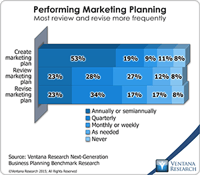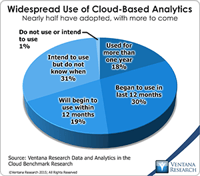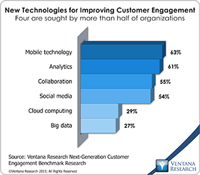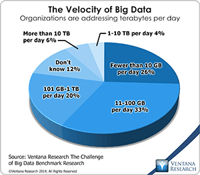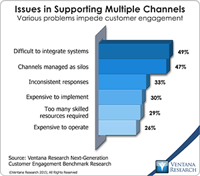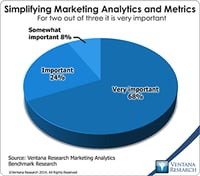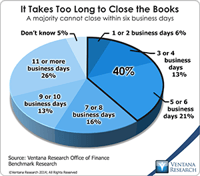As global business increases competitive pressures, marketing departments face new challenges. They must anticipate and respond to frequently changing customer preferences and produce effective programs and campaigns to attract them. In the online world where customers can jump instantly from one company to another, Marketing must develop new ways to catch and hold their attention. Doing this well requires systematic, flexible planning that begins with the CMO and engages the entire department...
Read More
Topics:
Sales Performance,
Customer Performance,
Operational Performance,
Financial Performance,
Uncategorized,
CMO
Cloud-based computing has become widespread, particularly in line-of-business applications from vendors such as Salesforce and SuccessFactors. Our benchmark research also suggests a rise in the acceptance of cloud-based analytics. We’ve seen the emergence and growth of cloud-only analytics vendors such as Domo and GoodData as well as cloud-based delivery by nearly all the on-premises analytics vendors. Almost half (48%) of organizations in our benchmark research on data and analytics in the...
Read More
Topics:
Sales Performance,
Supply Chain Performance,
Human Capital,
Business Intelligence, Business Analytics, Cloud,,
Customer Performance,
Operational Performance,
Business Analytics,
Business Intelligence,
Business Performance,
Cloud Computing,
Financial Performance,
Information Management,
Uncategorized
I have been involved in the contact center industry for more than 25 years and often see organizations that are slow in keeping up with consumers’ expectations; many of them seem reluctant to change, regardless of the need to do so. For example, agents of my cell phone operator ask the same four questions at the start of a call as they did 30 years ago; my bank supports several channels of communication, but it doesn’t provide the same information on all channels; and a well-known airline...
Read More
Topics:
Big Data,
Social Media,
Customer Performance,
Business Analytics,
Cloud Computing,
Uncategorized,
Call Center
Information technology enables a data-driven management style that was not feasible until powerful, affordable computers became generally available. There’s no bright line marking when this became possible; the process is ongoing. People were using financial analytics long before ENIAC, the first general-purpose computer, appeared, but the metrics available were not especially timely, broadly applicable to day-to-day situations or comprehensive enough to inform most management decision-making....
Read More
Topics:
Big Data,
Sales Performance,
Office of Finance,
Customer Performance,
Operational Performance,
Business Analytics,
Business Performance,
Financial Performance,
Uncategorized
For some people in sales and marketing who struggle to meet their quarterly targets, the blockbuster announcement that Microsoft will buy LinkedIn for US$26.2 billion may seem like a midyear holiday present: a digital business Rolodex filled with new global connections that can make the task of generating revenue dramatically easier. Problem is, sales leaders and revenue-focused marketers worth their weight already know everything there is to know about their target audience, and they’re taking...
Read More
Topics:
Sales Performance,
Social Media,
Business Analytics,
Business Intelligence,
Business Performance,
Cloud Computing,
Uncategorized,
Microsoft, LinkedIn, CMO, Sales
I recently attended the Interactive Intelligence Interactions 2016 conference and came away with four key insights regarding the company’s plans and progress in providing contact centers in the cloud. These include the short-term success of PureCloud, the company’s financial performance, the importance of customer support and dealing with change.
Read More
Topics:
Customer Performance,
Cloud Computing,
Uncategorized,
Call Center
There were two noteworthy themes in SAP CEO Bill McDermott’s keynote at this year’s Sapphire conference. One was customer assurance; that is, placing greater emphasis on making the implementation of even complex business software more predictable and less of an effort. This theme reflects the maturing of the enterprise applications business as it transitions from producing highly customized software to providing configurable, off-the-rack purchases. Implementing ERP will never be simple, as I...
Read More
Topics:
Predictive Analytics,
Sales Performance,
SAP,
Supply Chain Performance,
Customer Performance,
Business Performance,
Financial Performance,
Uncategorized
Managing marketing performance is anything but simple. It requires establishing a unified approach to assess the outcomes of initiatives and projects and compare results with investments in marketing people and campaigns. In general, while performance management has been conducted effectively at the corporate levels, it has been a challenge for most lines of business, marketing departments included.
Read More
Topics:
Sales Performance,
Social Media,
Marketing,
Marketing Performance Management,
Marketing Planning,
Operational Performance Management (OPM),
Customer Performance,
Business Analytics,
Business Intelligence,
Business Performance,
Uncategorized,
CMO,
Demand Generation
In our Office of Finance benchmark research 60 percent of participants said it takes their companies six or more business days to complete their quarterly close; that exceeds the best practice benchmark of five days. Consultants, academics and vendors have stressed the importance of shortening the close for almost a quarter of a century. The main reason for doing so is to provide executives and managers with timely information about the company’s performance. Yet our research shows that it’s...
Read More
Topics:
Office of Finance,
Business Performance,
Financial Performance,
Uncategorized
If you’re a sales or marketing executive or manager, your window of business opportunity is closing rapidly. In fact it started closing the day you began your job. Time is not on your side – and your career may well hang in the balance. I want to help you shift that balance to your advantage.
Read More
Topics:
Big Data,
Predictive Analytics,
Sales Performance,
Social Media,
Mobile Technology,
Business Analytics,
Business Collaboration,
Business Performance,
Cloud Computing,
Uncategorized,
Sales, Marketing, Sales Performance Management, Ma
